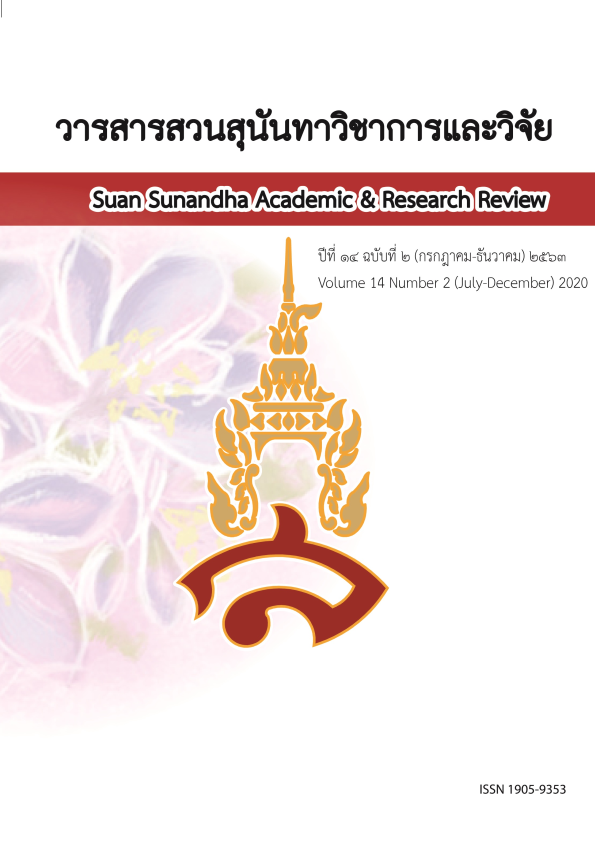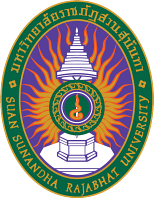รูปแบบอวตารการจัดการสาธารณสร้างสรรค์: นวัตกรรมการคิดใหม่การจัดการภาครัฐ สร้างความสามารถการแข่งขันยุทธศาสตร์เวชกรรมการแพทย์แผนไทย
คำสำคัญ:
อวตาร, การวิเคราะห์คุณค่าอวตาร, การจัดการสาธารณสร้างสรรค์, เวชกรรมการแพทย์แผนไทยบทคัดย่อ
ปัจจุบันนี้การขับเคลื่อนด้วยนวัตกรรมเป็นการอวตารสร้างกลุ่มอุตสาหกรรมอนาคตของเวชกรรมการแพทย์แผนไทย การวิจัยครั้งนี้มีวัตถุประสงค์เพื่อศึกษาสภาพการณ์ปัจจุบัน และสร้างรูปแบบอวตารการจัดการสาธารณสร้างสรรค์ ความสามารถการแข่งขันยุทธศาสตร์เวชกรรมการแพทย์แผนไทย กลยุทธ์การวิจัยในการบรรลุเป้าหมายใช้เทคนิคเดลฟายจาก ฉันทามติของ 18 ผู้เชี่ยวชาญจากภาครัฐและเอกชน ผลการวิจัยพบว่ามีความเด่นชัด ดังนี้ 1) รูปแบบอวตารงานวิจัยนี้ของการ จัดการสาธารณสร้างสรรค์ ประกอบด้วยปัจจัยทางอวตารการจัดการสาธารณสร้างสรรค์ธุรกิจนวัตกรรมและนวัตกรรมธุรกิจ รูปแบบนี้ถือเป็นรูปแบบนวัตกรรมของการใช้ประโยชน์ปฏิบัติ เรียกชื่อว่า “อยุธยาโมเดล” 2) ผลสุดท้ายมากสุดด้วยประยุกต์ อยุธยาโมเดลสู่การเป็นกลยุทธ์ขับเคลื่อนความสามารถการแข่งขันเวชกรรมการแพทย์แผนไทย ให้ชื่อว่า “สุนันทาโมเดล” ที่ยอมรับยุทธศาสตร์คำสำคัญที่ก้าวหน้า 2 ส. คือ เสริมสร้าง และ สนิทเสน่หา เสริมสร้างนั้นเป็นอวตารค้ำจุนความได้เปรียบ การแข่งขันทางความแกร่งของมูลค่าสินทรัพย์ที่เห็นไม่ได้และเห็นได้ ส่วนสนิทเสน่หา เป็นอวตารการทำตลาด (1) เชิงเชื้อเชิญ การทำตลาด (2) กลยุทธ์จุดขายง่ายๆ (3) มูลค่าส่วนเกินความคาดหมายลูกค้า การย้ายคุณค่า หรือสร้างอำนาจ (4) การงัดข้อ ต่อรองเหนือกว่าคู่แข่ง ความคิดริเริ่มที่ไม่ซ้ำแบบใครของสุนันทาโมเดลนี้ถือเป็นโมเดลยุทธศาสตร์ขับเคลื่อนกลุ่มอุตสาหกรรม อนาคต ซึ่งสามารถประยุกต์สร้างสรรค์สินค้านวัตกรรมภูมิปัญญาท้องถิ่น และหลักสูตรฝึกอบรมผู้ประกอบการกลุ่ม อุตสาหกรรมอนาคตและหมอพื้นบ้าน รวมถึงการมองทะลุแจ้งชัดสู่ความสำเร็จเวชกรรมการแพทย์แผนไทย
เอกสารอ้างอิง
Abell, A., & Oxbrow, N. (2006). Competing with Knowledge: The Information Professional in the Knowledge Management Age. London: Facet Publishing.
Amabile, T. M., Conti, R., Coon, H., Lazenby, J., & Herron, M. (1996). Assessing the Work Environment for Creativity. Academy of Management Journal, 39, pp. 1154-1184.
Arakji, R. Y., & Lang, K. R. (2008). Avatar Business Value Analysis: A Method for the Evaluation of Business Value Creation in Virtual Commerce. Journal of Electronic Commerce Research, 9(3), pp. 207-218.
Becker, B. E., Huselid, M. A., Ulrich, D., & Brockbank, W. (2015). Human Resources Management Success. The Ulrich Collection. Massachusetts: Harvard Business Review Press.
Bloch, C., & Bugge, M. (2013). Public Sector Innovation-From Theory to Measurement. Structural Change and Economic Dynamics, Elsevier, 27(C), pp. 133-145.
Brown, T., & Wyatt, J. (2010). Design Thinking for Social Innovation. Stanford Social Innovation Review. (Winter 2010), pp. 29-35.
Bruce, M., & Bessant, J. (2002). Design in Business: Strategic Innovation Through Design. New Jersey: Financial Times Prentice Hall.
David, M. E., David, F. R., & David, F. R. (2014). Mission Statement Theory and Practice: A Content Analysis and New Direction. International Journal of Business Marketing, and Decision Science, 7(1) (Summer), pp.95-110.
Devises, K. (2014). Handbook of Thai Traditional Medicine in Medical Treatment. Nontaburi: Institution of Thai Traditional Medicine.
Exon, F. (2018). The Australian Journal of Public Administration-Tracing the Study and Practice of Public
Administration for 81 Years. Institute of Public Administration Australia (IPAA). Retrieved August 31, 2019, from https://www.ipaa.org.au/the-australian-journal-of-public-administration-tracing-the-study-and-practice-of-public-administration-for-81-years/.
Ferlie, E. (2018). The New Public Management and Public Management Studies. New York: Oxford University Press.
Helliwell, J. F., Huang, H., Grover, S., & Wang, S. (2014). Good Governance and National Well-being: What are the Linkages? OECD Working Papers on Public Governance, No. 25 OECD Publishing. DOI: http://dx.doi.org/10.1787/5jxv9f651hvj-en.
Hill, G. E., & Hiltman, C. M. (2011). Research in Marketing and Entrepreneurship: Retrospective Viewpoint. Journal of Research in Marketing and Entrepreneurship, 13(1), pp.8-14. DOI: https://doi.org/10.1108/14715201111147914.
Hills, G. E., & Hultman, C. M. (2011). Academic Roots: The Past and Present of Entrepreneurial Marketing. Journal of Small Business and Entrepreneurship, 24(1), pp.1-10. DOI: https://doi.org/10.01080/082763312011.10593521.
Hood, C. (1991). A Public Management for All Seasons. Public Administration, 69, pp. 3-19.
Holzwarth, M., Janiszewski, C., & Neumann, M. M. (2006). The Influence of Avatars on Online Consumer Shopping Behavior. Journal of Marketing, 70(4), pp. 19-36.
Ivey, A. E., Ivey, M. B., & Zalaquett, C. P. (2013). Intentional Interviewing and Counseling: Facilitating Client
Development in a Multicultural Society. Boston: Cengage Learning.
Kaplan, A. M., & Haenlein, M. (2009). Consumer Use and Business Potential of Virtual Worlds: The Case of Second Life. The International Journal on Media Management, 11(3/4), pp. 93-101.
Kohler, T. (2015). Crowdsourcing-Based Business Models: How to Create and Capture Value. California:
Management Review, 57(4), pp. 63-84. DOI: https://doi.org/10.1525/cmr.2015.57.4.63.
Kongnguan, S. (2019). Trend of Thai Traditional Medicine within Phranakorn Sriayudhaya. Interview 3 September 2019.
Kotler, P., Kartajaya, H., & Seitawan, I. (2016). Marketing 4.0: Moving from Traditional to Digital. New Jersey:Wiley.
Kuczmarski, R. J. (1996). Bioelectrical Impedance Analysis Measurements as Part of a National Nutrition Survey. The American Journal of Clinical Nutrition, 64(3 Suppl), pp. 453S-458S.
Lasher, W. R. (2005). Process to Profits: Strategic Planning for a Growing Business. Ohio: South-Western Educational Publishing.
Li, J., Young, M., & Tang, G. (2012). The Development of Enterpreneurship in Chinese Communities: An Organizational Symbiosis Perspective. Asia Pacific Journal of Management, 29(2), pp. 367-385.
Likert, R. (1932). A Technique for the Measurement of Attitudes. Archives of Psychology, 22(140), p. 55.
Lee, P. D. (2008). Using Second Life to Teach Operations Management. Journal of Virtual Worlds Research, 2(1), pp. 14-16.
Macmillan, T. T. (1971). The Delphi Technique. Washington, D.C.: ERIC Clearinghouse.
Mesinsee, S. (2018). Startup Thai Herds and Health. National Herbs 13rd Festival Metropolitan: Thai Traditional Medicine and Alternative Medicine.
Ministry of Industry. (2559). Developing Strategy of Thai Industry 4.0 for 20 Years (2017-2036). Metropolitan.Ministry of Industry.
Olsen, T. L., & Tomlin, B. (2019). Industry 4.0: Opportunities and Challenges for Operations Management. Tuck School of Business Working Paper No.3365733, (March 7, 2019), pp. 1-20.
Pavaganun, C. (2012). Creative Public Management to Creative Industry: Rethinking Skill for Creative Education Era in Thailand. Innovation Administration and Management Review. Rajamangala University of Technology Rattanakosin, 2(2), pp. 1-20.
Pavapanunkul, S., & Mahittichatkul, N. (2020). Avatar Market-ing Research Methodology (First in the World).Metropolitan: Suan Sunandha Rajabhat University.
Pollitt, C., & Bouckaert, G. (2004). Public Management Reform: A Comparative Analysis. Oxford: OUP Oxford.
Porter, M. E. (1985). The Competitive Advantage: Creating and Sustaining Superior Performance. New York: Free Press.
Porter, M. E. (2019). The Strategy to Transform Health Care and Role of Outcome. Paris, France: OECD Policy Forum People at the Center: The Future of Health.
Rezazadeh, A., & Carvalho, A. (2018). A Value-based Approach to Business Model Innovation: Defining theElements of the Concept. Documentos de Trabalho Working Paper Series. Universidade Do Minho.
Rodger, P. A., & Clarkson, P. J. (1999). An Investigational Review of the Knowledge Needs of Designers in SMEs. The Design Journal, 1(3).
Rothwell, R. (1983). Innovation and Firm Size: A Case for Dynamic Complementarity. General Management, 8(3) (Spring).
Robinson, M. (2015). From Old Public Administration to the New Public Service: Implications for Public Sector Refrom in Developing Countries. Singapore: UNDP Global Center Public Service Excellence.
Sanyakorn, C. (n.d.). Handbook of Thai Traditional Medicine in Medical Treatment. Metropolitan (Publisher not Appeared).
Walsh, V., Roy, R., Bruce, M., & Potter, S. (1992). Winning by Design: Technology, Product Design and International Competitiveness. Oxford: Blackwell.
Woodman, R. W., Sawyer, J. E., & Griffin, R. W. (1993). Toward a Theory of Organizational Creativity. The Academy of Management Review, 18(2), pp. 293-321.
Zalaquett, C. P., Fuerth, K. M., Stein, C., Ivey, A. E., & Ivey, M. B. (2008). Reframing the DSM-IV-TR from a Multicultural/Social Justice Perspective. Journal of Counseling & Development, 86(3), pp. 364–371.
ดาวน์โหลด
รูปแบบการอ้างอิง
ฉบับ
ประเภทบทความ
สัญญาอนุญาต
บทความที่ได้รับการตีพิมพ์เป็นลิขสิทธิ์ของ สถาบันวิจัยและพัฒนา มหาวิทยาลัยราชภัฎสวนสุนันทา
ข้อความที่ปรากฏในบทความแต่ละเรื่องในวารสารวิชาการเล่มนี้เป็นความคิดเห็นส่วนตัวของผู้เขียนแต่ละท่านไม่เกี่ยวข้องกับมหาวิทยาลัยราชภัฎสวนสุนันทา และคณาจารย์ท่านอื่นๆในมหาวิทยาลัยฯ แต่อย่างใด ความรับผิดชอบองค์ประกอบทั้งหมดของบทความแต่ละเรื่องเป็นของผู้เขียนแต่ละท่าน หากมีความผิดพลาดใดๆ ผู้เขียนแต่ละท่านจะรับผิดชอบบทความของตนเองแต่ผู้เดียว






